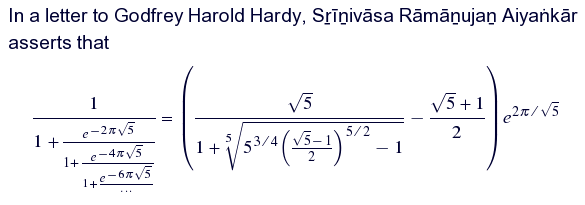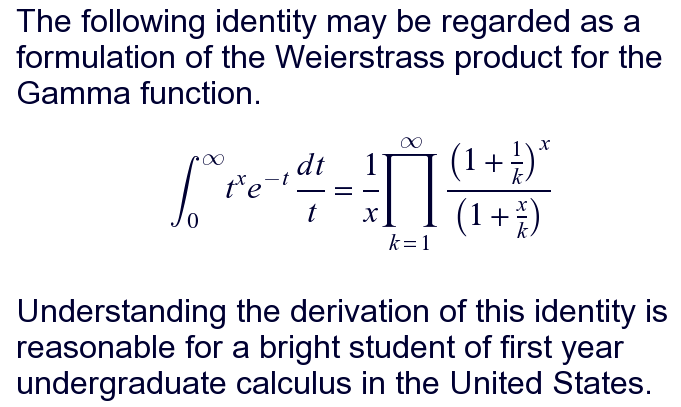Dual Presentation with Math from One Source using GELLMU
Preliminary Version of Talk for
the TUG Meeting in San Diego, July 2007
William F. Hammond
1. Introduction
A contemporary author writing an article for “dual presentation”
has in mind both the classical printed presentation of an article
and the modern web form of an article based on HTML.
There are two main approaches for achieving dual presentation
that are relevant to the TeX community.1
Write a LaTeX article, and use a program that translates
to HTML.
Write an article in a suitable XML document type, such
as DocBook or TEI, and use standard software
for generating LaTeX and HTML.
Both methods present challenges to authors who have been accustomed
to using LaTeX.
Since mid-2002 the second-generation form of HTML that supports
mathematical content has been supported by the two most widely
deployed web browsers, but not many articles seem to have appeared
on the web in this form so far. The most likely reason is difficulty
of production.
This talk will address the use of “generalized LaTeX” to
produce dual content from a single LaTeX-like source. This method
combines the reliability of XML document transformation with
many of the conveniences available when writing LaTeX markup.
2. Writing Source Markup
Here's the source for a relatively simple example.
-
The following identity may be regarded as a formulation of the
-
Weierstrass product for the Gamma function.
-
\[ \int_{0}^{\infty} t^x e^{-t} \frac{dt}{t} \int:
-
= \frac{1}{x}
-
\prod_{k=1}^{\infty}
-
\frac{\bal{1 + \frac{1}{k}}^x}{\bal{1 + \frac{x}{k}}}
-
\prod: \]
-
Understanding the derivation of this identity is reasonable for
-
a bright student of first year undergraduate calculus in the
-
United States.
It compiles to this:
- The following identity may be regarded as a formulation of the
Weierstrass product for the Gamma function.
Understanding the derivation of this identity is reasonable for
a bright student of first year undergraduate calculus in the
United States.
The markup looks like LaTeX. In fact, except for the use of the zone
closers \int: and \prod:, it would be LaTeX. I call it
generalized LaTeX.
Aside from the zone closers, which are required for GELLMU, there are a
few other things to notice. Most of these have to do with the fact that,
as part of the overall system design, markup semantics are independent of
the command vocabulary. Thus, for example:
Command arguments must be explicitly braced.
Braces for the argument of a superscript or subscript may be
omitted only if the argument is a single character.
The semi-colon at the end of a command name (such as \latex;
above) indicates that the command does not introduce content.
Often this type of semi-colon may be omitted, and, beyond that
for most purposes \foo; may be regarded as shorthand for
\foo{}.
The command vocabulary differs somewhat from that of LaTeX.
3. Another Example
There follows a GELLMU version of an example posted to the
UseNet newsgroup sci.math.research on 29 October 2002, message id:
<apmpvn$bpb$1.repost@nef.ens.fr>, by David
Madore of ENS for the purpose of comparing TeX markup to
MathML.
In a letter to Godfrey Harold Hardy, Sṟīṉivāsa
Rāmāṉujaṉ Aiyaṅkār asserts that
The markup for this:
-
\macro{\=}{\ovbar}
-
\macro{\.}{\ovdot}
-
\newcommand{\b}[1]{\unbar{#1}}
-
There follows a \abbr{GELLMU} version of an example posted to the
-
UseNet newsgroup \quostr{sci.math.research} on 29 October 2002, message id:
-
\href{http://groups.google.com/group/sci.math.research/msg/3bebf506912cf426}{
-
\quostr{<apmpvn\$bpb\$1.repost@nef.ens.fr>}}, by David
-
Madore of ENS for the purpose of comparing \tex; markup to
-
\abbr{MathML}.
-
-
\begin{quotation}
-
In a letter to Godfrey Harold Hardy, S\b{r}\={\i}\b{n}iv\={a}sa
-
R\={a}m\={a}\b{n}uja\b{n} Aiya\.{n}k\={a}r asserts that
-
\[
-
\frac{1
-
}{1+\frac{e^{-2\pi\sqrt{5}}
-
}{1+\frac{e^{-4\pi\sqrt{5}}
-
}{1+\frac{e^{-6\pi\sqrt{5}}
-
}{\ldots}}}}
-
=
-
\bal{\frac{\sqrt{5}
-
}{
-
1+\sqrt[5]{5^{3/4}\bal{\frac{\sqrt{5}-1}{2}}^{5/2}-1}}
-
-\frac{\sqrt{5}+1}{2}}
-
e^{2\pi/\sqrt{5}}
-
\]
-
\end{quotation}
Note the use of \bal{ ... } instead of the LaTeX usage
\left( ... \right). GELLMU has various balancers of this
type and will eventually have more. This is related not only to
the fact that the markup is simply a “front” for an SGML document type
but also to its notion of sound mathematical semantics. The processor
for XHTML+MathML output will not tolerate unbalanced balancing characters
in a math zone except as provided through these balancers and also
through the list generator
|
\vect[...]{...}{...} ... {...} . |
The kinds of weak enforcement of mathematical semantics represented
by such balancing provisions and by the requirement for explicit ending
of sum, int, and prod containers is prelude to
future optional incorporation of stronger mathematical semantics in
the markup.
Madore is correct in suggesting that one doesn't want to look
at the MathML markup for this, but the rendering by Firefox,
somewhat enlarged, is captured in this screenshot:
4. The Importance of XHTML+MathML
There are several reasons why it is important to have articles and
course materials with mathematical content online in modern HTML,
i.e., XHTML+MathML.
4.1. Public relations for Mathematics
To a young person XHTML+MathML represents “math on the web”.
It fits the paradigm of web browsing.
It's more flexible and more convenient for online reading
than PDF — doubly so by comparison with double-column online PDF.
The journals are disappearing from our libraries.
4.2. Special Needs
It's great for proof reading. (Enlarge and shorten the lines.)
Articles presented in XHTML+MathML comply with web accessibility
guidelines. (PDF with math does not.)
Large print editions at no cost.
The small gamma bit presented earlier may easily be made to
look like this in Firefox (a screenshot):
5. Compiling an Article
5.1. Acquiring the Software
GELLMU is based on cross-platform free software licensed under the
GNU GPL. Its package is available from CTAN
([2]) and from the GELLMU web site ([6]).
The package requires a number of other cross-platform free software
packages including GNU Emacs, Perl, and some standard items of
SGML/XML software, chiefly Open SP.
Linux: The required packages are generally part of a full
GNU/Linux distribution. The package should be installed in
/usr/local/gellmu and symlinks to driver scripts should be
made from a suitable place in one's command path.
MacOS-X and other Unix variants: The only difference from
GNU/Linux is that some of the supporting packages may need
to be acquired and installed.
MS Windows: The best strategy is to acquire and install a
full Cygwin distribution.
Then proceed as with Linux.
5.2. Procedure
Let's package the preceding markup segment as an article. Because
it is GELLMU, not LaTeX, it begins with \documenttype rather
than with \documentclass.
-
\documenttype{article}
-
\title{}
-
\begin{document}
-
-
The following identity may be regarded as a formulation of the
-
Weierstrass product for the Gamma function.
-
\[ \int_{0}^{\infty} t^x e^{-t} \frac{dt}{t} \int:
-
= \frac{1}{x}
-
\prod_{k=1}^{\infty}
-
\frac{\bal{1 + \frac{1}{k}}^x}{\bal{1 + \frac{x}{k}}}
-
\prod: \]
-
Understanding the derivation of this identity is reasonable for
-
a bright student of first year undergraduate calculus in the
-
United States.
-
-
\end{document}
Beyond early-stage syntatic processing the system requires that there
be a title in the preamble of every article. An empty
title is allowed.
Text normally must be in paragraphs. (There are exceptions.)
Therefore, the blank line after \begin{document} is essential.
It is sometimes said about LaTeX that a blank line ends
a paragraph. However, in GELLMU a blank line begins a
paragraph.
We place this article text in a file named gammabit.glm, with
“.glm” the canonical suffix for a GELLMU source file,
enter the command
- mmkg gammabit
and prepare to read the scroll. At the end when
all goes well there are the following outputs:
Additionally one might note that some level of rendering based on
cascading style sheets (CSS) is possible for the
author-level XML.
In order to understand the scroll one needs to understand the
system design.
6. System Components
Regular GELLMU is a system assembled from modular components.
Each step along the way produces an intermediate stage output
that has its own sense and that, when things go wrong, provides
opportunity both for diagnosis and intervention.
Here's the flow chart:
What I call the “side door” is the second row entry showing
the possibility of translation from source languages other than
the markup of regular GELLMU into the author-level XML documenttype
corresponding to the source markup of regular GELLMU.
One will note from the scroll that SGML/XML
validation is done at several stages. This validation can be
important for catching the author's mistakes. When there are error
messages, it is possible and important to consult the scroll's last
message regarding the stage of processing. Note in this regard
that the translation from elaborated XML to XHTML+MathML takes place
in 3 stages that are not shown on the chart but that may be seen
in the example scroll.
7. Further Information
Much more information may be found in the User Guide ([3]),
the GELLMU Manual ([4]), and the GELLMU web site,
http://www.albany.edu/~hammond/gellmu/.
A link to an online version of this preliminary document should be
available at the GELLMU web site by July 6.
REFERENCES
- [1]
William F. Hammond,
“GELLMU: A Bridge for Authors from LaTeX to XML”,
TUGBoat: The Communications of the TeX Users Group, vol. 22 (2001),
pp. 204–207; also available online at
http://www.tug.org/TUGboat/Contents/contents22-3.html.
- [2]
GELLMU at CTAN:
http://www.tex.ac.uk/tex-archive/help/Catalogue/entries/gellmu.html
- [3]
William F. Hammond,
“Introductory User's Guide to Regular GELLMU”,
http://www.albany.edu/~hammond/gellmu/igl/userdoc.xhtml (PDF).
- [4]
William F. Hammond,
“The GELLMU Manual”,
http://www.albany.edu/~hammond/gellmu/glman/glman.xhtml (PDF).
- [5]
“New York Journal of Mathematics Articles in
Mathematically-Capable HTML”; demonstration versions of past articles
from The New York Journal of Mathematics ported from classical
LaTeX using GELLMU.
- [6]
The GELLMU web:
http://www.albany.edu/~hammond/gellmu/
Footnotes
- * Texinfo, the language of the GNU Documentation System,
also provides a route for dual presentation of articles without
mathematical markup.


